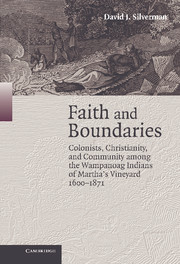 Faith and Boundaries
Faith and Boundaries Book contents
- Frontmatter
- Contents
- Maps, Tables, and Figures
- Abbreviations
- Preface: Do Good Walls Make Good Neighbors?
- Introduction: Epenow's Lessons
- 1 “Here Comes the Englishman”
- 2 To Become All Things to All Men
- 3 The Lord Tests the Righteous
- 4 Deposing the Sachem to Defend the Sachemship
- 5 Leading Values
- 6 The Costs of Debt
- 7 “Newcomers and Strangers”
- Conclusion: Fencing In, Fencing Out
- Appendix A The Population of Martha's Vineyard
- Appendix B A Cross-Comparison of Indian Race Descriptions
- Index
1 - “Here Comes the Englishman”
Published online by Cambridge University Press: 17 December 2010
- Frontmatter
- Contents
- Maps, Tables, and Figures
- Abbreviations
- Preface: Do Good Walls Make Good Neighbors?
- Introduction: Epenow's Lessons
- 1 “Here Comes the Englishman”
- 2 To Become All Things to All Men
- 3 The Lord Tests the Righteous
- 4 Deposing the Sachem to Defend the Sachemship
- 5 Leading Values
- 6 The Costs of Debt
- 7 “Newcomers and Strangers”
- Conclusion: Fencing In, Fencing Out
- Appendix A The Population of Martha's Vineyard
- Appendix B A Cross-Comparison of Indian Race Descriptions
- Index
Summary
Wuttununohkomkooh knew of God long before the English settled on Noepe. For years, she and her husband, Pammehannit, had unsuccessfully tried to build a family, thrice conceiving and pouring their hopes into the promise of a forthcoming child, only to lose each infant within days of delivery. The would-be mother turned to Indian shamans and doctors for help, but their medicine was of no use; two more births ended just like the ones before. Wuttununohkomkooh's sixth pregnancy in 1638, then, was not a time of joy and anticipation but of overwhelming anxiety.
Filled one day with a sense of impending doom, Wuttununohkomkooh went to a solitary field where she could grieve unrestrained. But as she bewailed her former losses and cringed at the prospect of another, an invisible herald brought her news that his master, the source of all life, was willing to spare her forthcoming babe if she petitioned him for mercy. The expectant mother took this message seriously and carefully followed the instructions. Some time later she bore a son, and within a few weeks it was clear that Wuttununohkomkooh's and Pammehannit's years of suffering were over; this child would live. Overjoyed, Wuttununohkomkooh dedicated the newborn, later known as Japheth Hannit, to serve the deity that had lifted the curse on her family.
- Type
- Chapter
- Information
- Faith and BoundariesColonists, Christianity, and Community among the Wampanoag Indians of Martha's Vineyard, 1600–1871, pp. 16 - 48Publisher: Cambridge University PressPrint publication year: 2005


